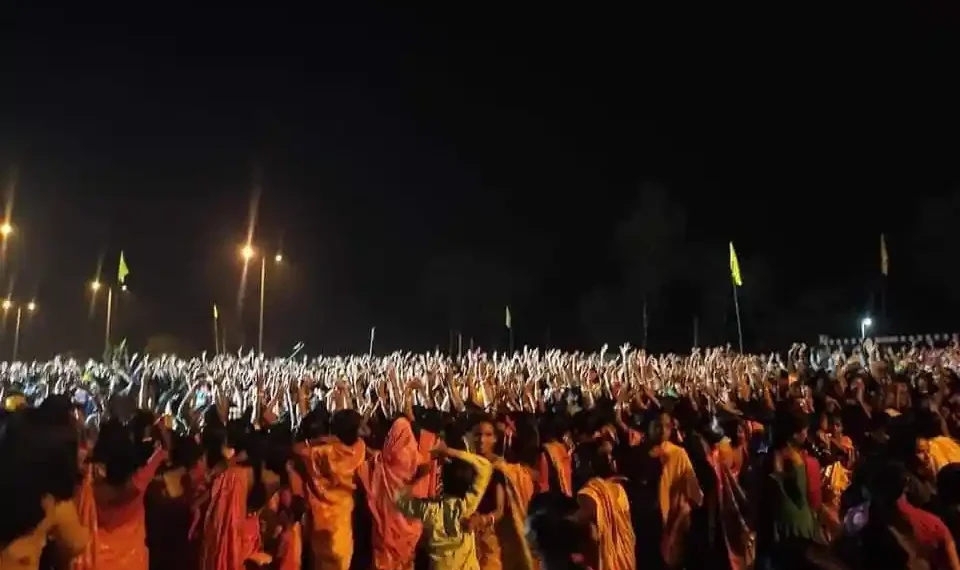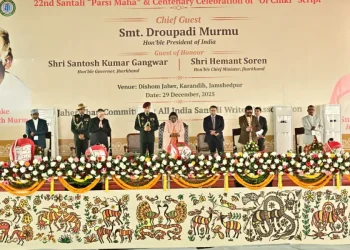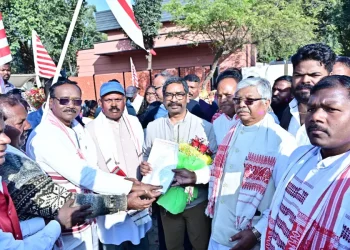Kolkata
Ranjit Mahato a school teacher of history in Purulia, points out how the “secretary of Lord Curzon had admitted to the fact of the Kurmis being the early inhabitants of India,” with a history of more than 4,000 years.
With a little more than 50 lakhs in numbers, the Kurmis who account for anywhere between 17 to 30 percent of total percentage of voters in Purulia, Bankura, Jhargram and Midnapore districts, the Samaj has been asking for:
- “The recognition of totemic Kudmi community — delisted from the Schedule Tribe list when it was being prepared in 1950 — as scheduled tribes.”
- “Recognition and enlistment of the Kudmali language in the Eighth Schedule of the Indian Constitution.”
- “Recognition and Codification of Sarna Religion considering the fact that the community worshipped nature notwithstanding the infiltration of Brahminism in its culture.”
- “The preserving of primitive tribe culture.”
To press for these demands, thousands of Kurmis including a sizeable number of youth across South Bengal’s Jangalmahal area blockaded roads and railways in more than one tranches in 2023 before.
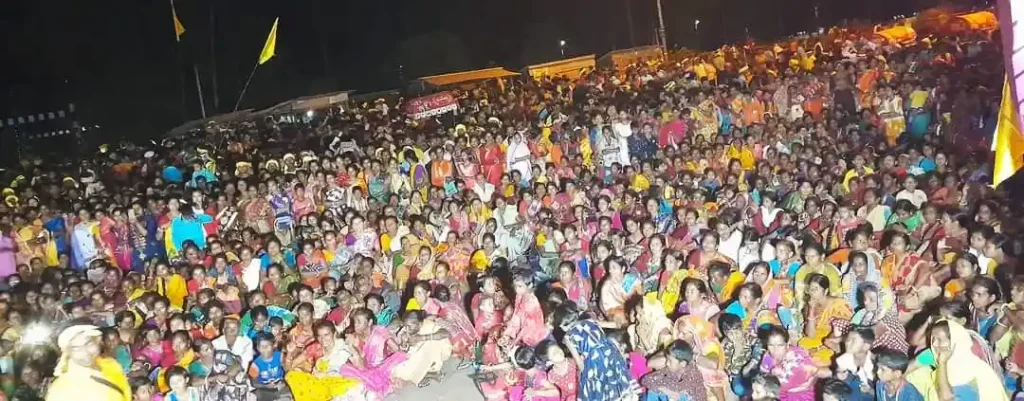
The History
The Kurmi Mahato community share a valiant history of playing a role in various rebellions in the Indian freedom struggle. From the Chuar rebellion to the Quit India Movement, the Kurmis played a big role in the history of anti-British struggle. The likes of Raghunath Mahato have earned special fame in the history for his famous coinage: “Apna Gaon, Apna Raaj; Dur Bhagao Bideshi Raaj. (Hail, Hail Motherland and self-rule, Down, Down Foreign Rule.”
Gopal Mahato of Indigo Rebellion and Chanku Mahato of Santhal uprising too got their names inscribed in history. Such was their valour that 11 Kurmis were hanged to death for taking part in the Sepoy Mutiny.
“There are many more names that only underscore their valour, grit … that they are fiercely independent minded only shows that this movement will not end easily,” says a social worker from Purulia requesting anonymity.
The successive governments have often identified the Kurmis as synonymous with the Kunbi who were traditional tillers of land.
As per another tradition the “Kshatriya of Aryan fame got divided into three sub-classes – Rajan Kshatriya (Kings and leaders), Kshatriya (warriors), and landlords termed as Kurmi Kshatriya. The Kurmi Kshatriya did farming during the peacetime and helped the army during war. Later, those working only on farms became known as Kurmi.”
Hence, “Kurmi — which in Sanskrit means ‘the ability to do’ — is a Vedic Kshatriya caste made for those Kshatriyas that have opted agriculture or farming as their main occupation”.
According to Crooke, the Kurmis were famed as market gardeners. In western and northern Awadh, for example, for much of the 18th century, the Muslim gentry offered the Kurmi highly discounted rental rates for clearing the jungle and cultivating it.
The Kurmis of Chotanagpur and more relevant in this case of Jangalmhal are loath to be identified as a variation of the Kshatriya clan. They claim their origin descent from Totemic Kurmi tribes which bear a Dravidian strain and dismiss the attempt of “wrongly identifying us with Kurmis of Bihar and north India.” But that is a debatable topic.
The Debate
On May 3, 1913, and December 16, 1931, the then British Government’s home and Judicial departments published notifications (No.550 and 3563-J) in The Gazette of India where Kurmis were mentioned alongside other tribes: Munda, Oraon, Santal, Ho, Bhumij, Kharia, Ghasis, Gond, Sauria and Pan etc.
It was stated in the notifications that the tribes enjoyed exclusive customary rules of succession and inheritance most of which were ill-assorted with the provisions of the Indian Succession Act of 1865 and 1925 — iterating thereby that the relevant provisions of the Acts were inexpedient to apply in the case of tribal people.
Other documents abound too establishing the fact how the Kudmis were classified as Notified Tribes by British in respect of the Indian Succession Act.
In his book The Tribes and Castes of Bengal (1891), Herbert Hope insists that the “Kudmis follow totemism which stamps their Dravidian descent. Totemism, according to Encyclopaedia Britannica, is a system of belief in which humans are said to have kinship or a mystical relationship with a spirit-being, such as an animal or plant. The entity, or totem, is thought to interact with a given kin group or an individual and to serve as their emblem or symbol. totem fish mask.
The proximity in time of 1891 — when Hope afforded hope to the Kudmis — and 1913 when they get recognized as primitive tribes by the powers that be should not go unnoticed. This, however, goes without saying that they are suddenly de-listed as tribes in the 1931 census.
If the British had some hidden design in doing so post Independence they remained ignored in the list drawn up in 1950 too. Kurmis are presently listed as Other Backward Class.
According to a senior official of the Bengal Government, “The Tribal Research Institute of Government of India preferred to ignore the recommendation of the Government and the matter still hangs in the balance.”
Sources in the TRI quoted the Census of 1872 where “the then Government did not mark Kurmi-Kudmi as Tribes or Wood Tribes but mentioned them as Jari Kurmi or Kurmi of the Woods. It has also been clarified by the Revenue and Land Reforms Department that Kurmi (Mahto) is listed in the list of backward classes under the Chotanagpur Tenancy Act (CNT), 1908.”
Quite contrarily Wing Commandar Hyaneshwar Singh in his Tribal Identity and Kurmi Mahtos A TRI Case Study, finds a 4000-year history of the tribal Kurmi community in Chotanagpur Pleatueau. And it goes without saying that geographically speaking Jangalmahal is not only contiguous to Chotanagpur pleateau but also extension of it.
There have been conflicting views on the historical past of the Kurmi community.
In an acerbic peace of research work. Lakshmi Kanta Mahato, an Assistant Professor in Political Science in Purulia. tends to note a number of reasons why the Kurmis have not been accorded the tribal status even 75 years after Independence. According to him, the powers that be had adopted the same divide and rule policy against the Kurmis a la the British.
Considering the historically rebellious nature of the Kurmis, which can be proved by the multiple movements they took part during the freedom struggle. the government wanted to keep them divided which is why the Manbhum that once boasted of 3.5 lakh Kurmi people was divided and a separate Purulia district was created and merged into Bengal, he asserted.
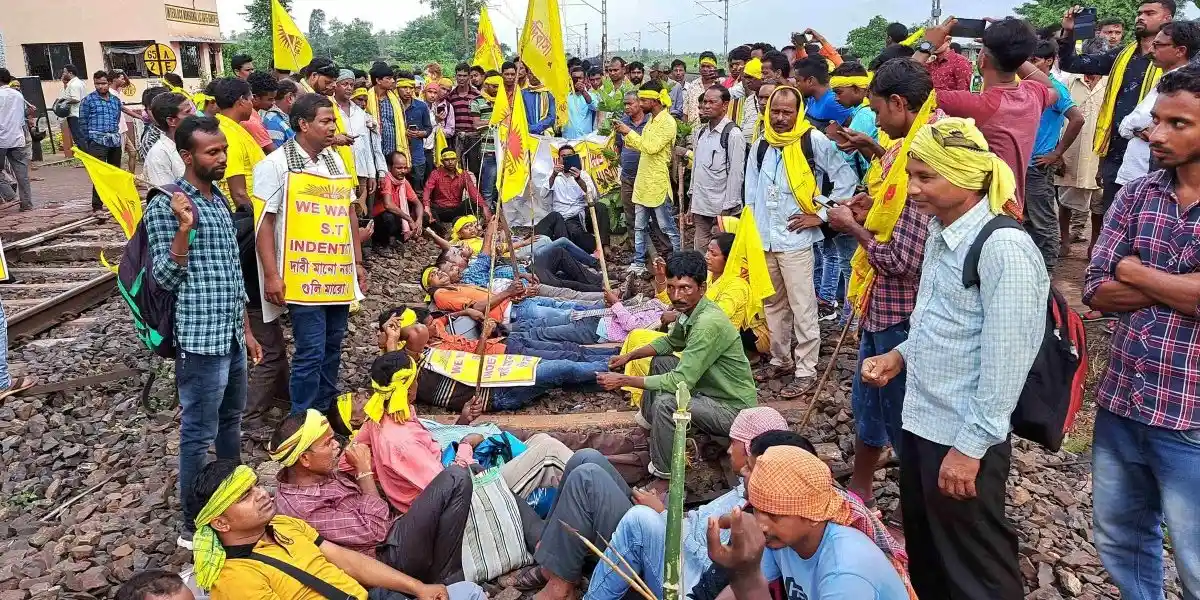
This was apparently done to divide them in fractions and deny them the chance of uniting and raising their voices against acquisition of lands in the name of large industries that came up in Bokaro, Dhanbad and Jamshedpur.
This theory, he said, is also supported by anthropologist Dr. Pashupati Prasad Mahato in his much debated book “Sanskritization and Nirbakization.”
The Professor ascribed “Brahminical” and “Hindu chauvinistic” politics as yet another reason to deny the Kurmis their rights. He said that in their bid to maintain the number of Hindus higher than that of the Muslims, the Kurmis were forcibly kept in the Hindu fold whereas they had a separate Sarna religion where elements of almighty are found in the Nature and trees and hills are worshipped.
“Even today, tribal people are forced to write their religion as Hindu in every official paper as their Sarna religion is still not codified and recognized by the government” he pointed out.
Besides, the government failed to differentiate the “Kurmi” community of Bihar and Northern India and the totemic “Kudmis” of Chhotnagpur (as also the Jangalmahal) region and as a result it recognized them all as “Kurmi”. “This generalization and misconception led to the path of exclusion of Kudmi community as a tribe.”
The Tribal Pushback
The other groups like those from the Santhal, Munda or Oraon, however, are against giving tribal status to the Kurmis.
Though Bengal minister Birbaha Hansda, a Santhal leader, would not speak openly on the issue other members of her community resent any move to afford the Kurmis a tribal status. They base their argument on two points.
A local reporter Asif said that the Santhals or for that matter other tribes would not want the Kurmis to be included in the Sixth Schedule of the Constitution as “this would afford the Kurmis the chance to acquire the lands of the other tribal communities. More so, because the Kurmis are economically far stronger a community than the Santhals or Mundas who are very poor and fear the loss of whatever land they have in their possession.”
Besides, the other tribal communities fear loss of jobs under the ST category to the Kurmis who are once again far more educated and have access to good or at least better schooling than the rest of the tribal communities, he added.
This is the reason why the Santhals and Mundas had organized an equally large counter-movement to offset the impact of the Kurmi rallies in the Janglamahal districts of Jhargram, Midnapore, Bankura and Purulia.











